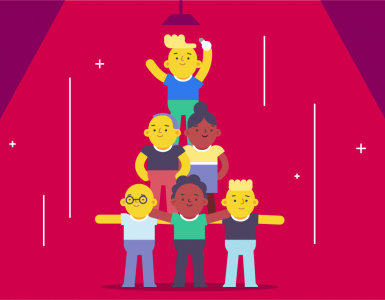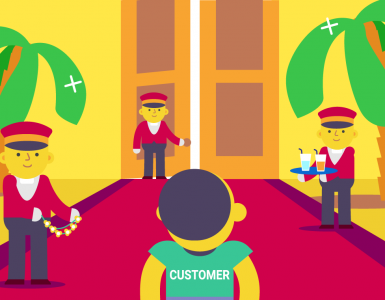There’s something powerful about a workplace where laughter echoes, ideas flow freely, and each person feels like they really belong. Let’s face it, though-too many days, the grind takes over and that magic of connection gets lost. Team members are sitting side by side and working remotely, working on tasks, but that spark which lets them feel a part of something big starts to burn out.
That is why employee engagement activities are important; they are not just niceties, but the pulse of any thriving team. It’s a constant reminder that they are not just roles or designations; they’re valued, appreciated, and needed for the bigger picture. Through well-thought-of employee engagement programs, you will be able to create an environment where collaboration is not forced but natural, where teammates support each other, celebrate wins together, and find meaning in their work.
Employee engagement is much more than a shot in the arm. It’s about creating that space where people can be seen and heard; a place where every person feels they are part of something special. If you’re trying to figure out how to develop those bonds and bring your team closer together, here are some heartfelt employee engagement initiatives to help inspire your journey.
1. Team building games
Team-building games are excellent engagement activities that can keep your employees occupied yet having fun. These events enable your team to work together and are supposed to be enjoyed easily. The concept is simple wherein employees participate in games that involve teamwork, solving problems, and communicating with each other. It can be anything from a simple icebreaker game to an extreme scavenger hunt.
How it works:
It can be either an outdoor activity, a virtual challenge, or even office-friendly games-whatever your team wants. The main aim is to get employees to start working with each other out of their usual roles. Activities that break the ice get collaboration going and allow employees to express skills they might not regularly use at work.
How to organize it
- Pick a game: Depending on the team dynamic, select an activity that best suits. If it’s a remote team, then virtual games will do just fine. For in-person teams, you can try something physical such as a scavenger hunt or relay races.
- Set the scene: Make it casual so that everyone is at ease. A no-pressure environment encourages full participation.
- Assign roles: You don’t have to go overboard here. Generally, a facilitator will do to establish the rules and keep things running smoothly.
Why it’s effective:
Team-building games break barriers and make people communicate beyond their given lines. Employees learn to trust one another, become acquainted, and understand how to work towards a mutual goal. The activities also help in boosting morale; employees feel connected to each other and to the company at large.
Key outcomes:
- Better communication: Employees learn how to communicate better in an environment that is casual.
- Increased trust: The team members start trusting one another more when they work on funny tasks.
- Better relationships: These activities help your employees bond on a personal level and translate into better teamwork.
Why not give this activity a try at your next meeting or company event? This is a very easy way to keep the positive vibe alive in your work environment, and your team will most definitely thank you-and possibly be asking for more games!
2. Group volunteer activities
Group volunteering offers an excellent opportunity to boost employee engagement while contributing to the community. When your team joins together for a shared purpose, it strengthens relationships, builds pride, and enhances teamwork. These activities unite employees around a meaningful cause, fostering a sense of belonging and achievement.
How it works:
Group volunteer activities entail teams coming together to work on either a community service project or a charity initiative. It’s like sending positive vibes en masse toward one cause that will benefit others. Such activities not only just help the community but will also help staff connect and display teamwork spirit for a common purpose.
How to organize it:
- Choose a Cause: First, ask your team about what causes they care about: environmental conservation, education, or food insecurity. Make sure to choose something your employees care about to make participation higher.
- Partner with Organizations: Contact local charities and nonprofits. They will many times have programs ready to take part in, which would make planning much easier.
- Make It Fun: Add a light-heartedness to it, like some friendly competition (“Which team can pack the most donation boxes?”) or even take a group photo session for keepsakes.
Why it’s effective:
Volunteering enables the intrinsic drive to help others. When employees work together for a great cause, they gradually become closer and share a mutual feeling of pride. Besides, some time off from everyday work stresses allows workers to return more engaged.
Key outcomes:
- Improved morale and motivation: The sense of achievement and shared purpose that volunteering fosters can have a positive impact on overall job satisfaction.
- Increased teamwork and communication: Employees bond through working on a volunteer project and learn to work better together.
- Positive company image: Employees are proud to be part of a company concerned with social responsibility, which creates greater engagement and loyalty.
So why not make your next team outing a volunteer day? Because it is an amazing way to give back to the community and help nurture those bonds of the people within the team. After all, the best teams are those that lift each other up-both in and out of the office.
3. Hackathons and innovation challenges
The whole concept of hackathons and innovation challenges is to unlock creativity and thinking out of the box. Usually, teams are put together in such events to brainstorm and work on solving a problem or creating something new within a certain time, such as a day or over a weekend. It’s a high-energy collaborative experience that drives engagement by allowing employees to take ownership of projects, try new things, and see the results of their creativity.
How it works:
The format is pretty simple. There is a problem or challenge that participants, often in teams, develop the solution or prototype for. This could be anything from a simple design for a new feature on an existing product to a more complex development of a totally new business idea. Though Hackathons can be technical, that is not a must since innovation challenges can be all over, including marketing ideas down to community outreach projects.
How to organize it:
- Set a theme or challenge: Select a problem relevant to your business or industry. It should be something that excites participants and allows room for creative solutions.
- Provide tools and resources: Make sure participants have access to whatever tools they might need, whether it’s software, research materials, or anything else.
- Form teams: Divide employees into teams, mixing different departments and skills to come up with diverse ideas.
- Time constraint: A reasonable time frame, such as usually 24-48 hours for a hackathon, keeps the energy going.
Why it’s effective:
Hackathons engage employees, offering them an opportunity to think outside their daily tasks and look at their work process from another angle. Through these events, you can promote collaboration, inspire creativity, and help every employee feel like they’re part of something larger.
Key outcomes
- Boosted engagement: Employees feel more involved and motivated when they contribute ideas that could directly impact the company.
- Stronger collaboration: These events encourage cross-departmental teamwork, helping employees build relationships.
- Increased innovation: You’ll likely discover new ideas and solutions that wouldn’t have surfaced through regular work routines.
Think about hosting a hackathon at your next company event: a fun, productive way to engage employees, build team spirit, and generate fresh ideas-all while having a little fun along the way!
4. Lunch & Learn sessions
Ever felt that employees get so engulfed in work that they forget the educative aspect? Well, Lunch & Learn sessions remedy all that. These are events mostly made in one hour, combining education with socialization, allowing your workforce to gain new knowledge over lunch together. It’s a win-win!
How it works:
A typical Lunch & Learn session involves an internal or external speaker who shares ideas on anything from industry trends to personal development. Sessions take place during lunchtime, allowing employees to eat, relax, and interact with the content. You can host them weekly, monthly, or whenever needed, depending on your team’s schedule.
How to organize it:
- Pick a topic: Select a topic relevant to your team’s interests or challenges.
- Find a speaker: Invite an expert from within or outside the company. This can be a leadership representative from another department, a guest speaker, or even a member of your team with specific knowledge.
- Set the time: Also, plan the session around a natural break in the day-say, lunch-and keep the session short, focused, and interactive.
- Provide lunch: offer lunch, be it catering, pizza, or as simple as sandwiches. Encourage participation: make the atmosphere open for questions and the sharing of thoughts.
Why it’s effective:
Lunch & Learn sessions make learning combine with social interaction, something less formal and more amiable. This would give some time for professional growth but also make their relationships in the office close and warm. And the best part is that they dissolve silos, making for better knowledge-sharing across teams.
Key outcomes:
- Enhances employee engagement and satisfaction: Employees generally appreciate learning opportunities to grow through.
- Promotes collaboration: Team members get to understand each other as they show and share different insights on a particular matter.
- Improves morale: A light-hearted, fun learning environment contributes to great vibes.
Ready to dish up some knowledge? Plan your first Lunch & Learn in the upcoming month and watch your team savor bites of food with engaging moments of enlightenment over valuable insights.
5. Employee appreciation days
Employee Appreciation Days are exactly what they sound like – a dedicated time to recognize and celebrate your team’s hard work and contributions. These days are not only about putting smiles on their faces but are actually a meaningful way to give a boost to morale, loyalty, and workplace culture by letting your people know that their efforts are valued. After all, who doesn’t like appreciation?
How it works:
Days of employee appreciation come in all shapes and sizes, from catered lunches to personal thank-you notes to fun events, like a team outing or office awards ceremony. The idea is to sincerely show appreciation for them in a manner with which they identify.
It doesn’t have to be anything major. Sometimes, it’s the little acknowledgments – a gift card, an afternoon off – that really make someone’s day. The key is to tailor the activities to your team’s preferences. If they love good food, host a themed potluck or bring in a food truck. If they’re competitive, set up a mini-games tournament. The options are endless, as long as the focus is on celebrating your people.
How to organize one:
- Plan Ahead: Choose a date and then set a budget. It does not have to be an expensive one; more often, creativity beats cash.
- Customize the Experience: Survey employees or take input from previous events to design something meaningful.
- Make It Personal: Add a personal touch, such as handwritten notes from leadership or shoutouts for specific accomplishments.
Why it’s effective:
Employee Appreciation Days work because they tap into a universal human need: the desire to feel valued. When employees see their hard work valued, they will feel connected with the organization and be motivated to raise the level of performance accordingly. A small investment for huge returns in morale and engagement.
Key outcomes:
- Improved Employee Morale: Employees are happier and more connected with their work.
- Stronger Team Bonds: Shared celebration enhances camaraderie.
- Improved Retention: The appreciated employees will make them more likely to stay longer.
Have you not had an Employee Appreciation Day? Keep it simple by starting with a team lunch or surprise treat day as ways of saying, “thank you,” in a very big manner. Remember that sincerity outranks sparkle. Be sincere and make sure your heart goes there; your team will indeed notice.
6. Workshops and Skill-Sharing Sessions
Workshops and skill-sharing sessions are great ways to reveal the hidden talent of your team into active knowledge. In such activities, employees get a chance to share expertise on selected topics. It helps in developing a culture of collaboration and learning within the team. Be it deep-diving into some technical skill, soft-skill development sessions, or creative brainstorming sessions, these can engage your team and drive growth.
How it works:
It may be performed either by employees or by invited professionals, depending on the theme. One employee can organize a workshop on time management skills, and another can share how to work in correspondence with coding standards. A high level of interactivity provides good opportunities for discussion, developing one’s communicational skills in general. From 30-minute talks, the sessions may continue up to a full-day workshop, depending on how complicated the subject is.
How to organize it:
- Identify the skills: through asking what employees would want to develop or expertise that they are willing to share. It helps in making sessions relevant to the team.
- Set the agenda: Define the objectives of the workshop. Is it for skill development or is it to foster creative problem-solving?
- Choose the format: Will it be a lecture style of presentation, or hands-on, interactive workshop?
- Logistic planning: Book a room, provide materials, and decide if lunch or refreshments will be available. Make sure interaction is achieved through Q&A sessions, group activities, or case studies.
Why it’s effective:
The skill-sharing workshops help employees learn from each other and feel connected to the team; besides, they feel a sense of achievement when they can contribute to others’ learning. This activity also enhances cross-team collaboration and improves problem-solving capabilities.
Key outcomes:
- Improves employee engagement: Employees feel valued once they are given an opportunity to teach and learn.
- Fosters collaboration: Team members bond through the sharing of knowledge and skills.
- It increases productivity: Acquiring certain new skills or methods can positively impact performance and efficiency immediately.
Hold your first workshop on something simple, like how to use a project management tool or the best practices for client communication. This will help your team become more responsive, and this will boost their engagement!
Benefits of employee engagement
Employee engagement is more than a buzzword; it’s the magic ingredient that takes good teams and makes them great. But what’s really in it for you, the leader? Plenty.
First, engaged employees are happy. And let’s be frank, who doesn’t want a happier team around them? When people invest themselves in their work, they start to give way more than what has been prescribed for them. They show up energized, ready to knock down challenges, and bring elbow grease to move the company forward.
But that’s not all: engaged employees are more productive. Think of it: the more people are motivated, the faster and at a higher quality they do their tasks. It just is like running to the finish line either with enthusiasm or dragging oneself to the line. Which one would you want?
And then, there is loyalty. The engaged employee tends to stay, for he feels a purpose-be it in the work of the company or through it, he belongs. This helps to cushion them against the many attractive open opportunities. This could be priceless in today’s competitive job market.
And then there’s the ripple effect: One person gets engaged, and suddenly there’s an upward spiral in team collaboration, improvement in communication, faster problem solving-and generally, a work atmosphere that’s appealing rather than endured.
In other words, investing in employee engagement is investing in your team’s success. And that’s something everybody can get behind.
Final note
After all is said and done, employee engagement activities are more than just about fun or what is trendy – they build strong, connected teams. With a focus on activities like team-building games, group volunteering, and innovation challenges, you foster an environment where collaboration and creativity thrive. Programs such as these are not about checking boxes but create lasting bonds, boost morale, and keep employees valued and appreciated.
If you want to engage your employees now, you could start small. Do something as simple as organizing a casual, light-hearted team-building game or a session of Lunch & Learn. Try appreciating your team for working hard with a simple day. These don’t have to be elaborate but are key. Consistency and sincerity will make the employees understand their worth, which automatically builds their motivation.
Remember, a connected workplace is a successful and happy workplace. Take one minute to reflect on what will resonate with your team the most, and start building those moments of connection. Your efforts will lead to stronger relationships, higher morale, and ultimately, a more successful, engaged workplace.









